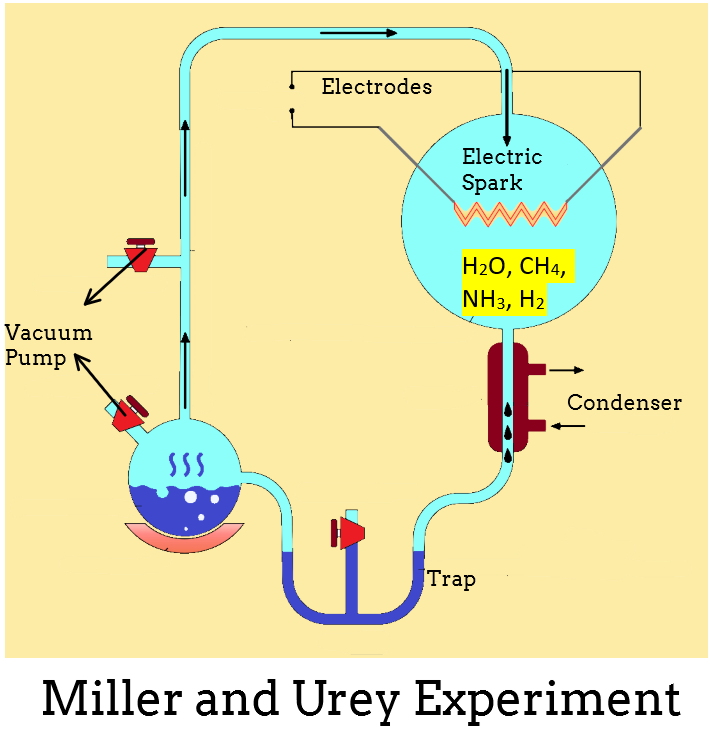
Stanley Miller and Harold C. Urey performed an experiment by recreating in the laboratory the probable conditions of the atmosphere of the primitive earth. In what forms was the energy supplied for the chemical reactions to occur?
Answer
499.5k+ views
3 likes
Hint: The primitive earth experienced extensive lightning that transformed the biological forms by oxidation and reduction of their chemical constituents.
Complete answer:
Miller and Urey used electrodes as the source of energy (which produced electric discharge in the form of a spark) in their experiment.
Miller and Urey experiment: The two biologists used water, methane, ammonia, and hydrogen which they believed were present in the early earth’s atmosphere. The chemicals were sealed inside sterile glass tubes and flasks connected together in a loop and circulated inside the apparatus.
One flask is half-filled with water and the other flask contains a pair of electrodes. The water in one flask was heated and the vapor released was added to the chemical mixture. The released gases circulated around the apparatus imitated the earth’s atmosphere. The water in the flask represents the water on the earth’s surface and the water vapor is just like the water evaporating from lakes, and seas. The electrodes were used to spark the fire to imitate lightning and storm through water vapor.
The vapors were cooled and the water condensed. This condensed water trickles back in the first water flask in a continuous cycle. After a week Miller and Urey analyzed the cooled water and observed that 10-15% of the carbon was in the form of organic compounds. It also led to the formation of 13 amino acids, fatty acid, and sugar.

Note: The Miller and Urey experiment (1952) also supported Oparin and Haldane’s experiment. It established that life arose gradually from inorganic molecules with the help of amino acids forming first and then they give rise to other biomolecules like proteins, glycoproteins, etc.
Complete answer:
Miller and Urey used electrodes as the source of energy (which produced electric discharge in the form of a spark) in their experiment.
Miller and Urey experiment: The two biologists used water, methane, ammonia, and hydrogen which they believed were present in the early earth’s atmosphere. The chemicals were sealed inside sterile glass tubes and flasks connected together in a loop and circulated inside the apparatus.
One flask is half-filled with water and the other flask contains a pair of electrodes. The water in one flask was heated and the vapor released was added to the chemical mixture. The released gases circulated around the apparatus imitated the earth’s atmosphere. The water in the flask represents the water on the earth’s surface and the water vapor is just like the water evaporating from lakes, and seas. The electrodes were used to spark the fire to imitate lightning and storm through water vapor.
The vapors were cooled and the water condensed. This condensed water trickles back in the first water flask in a continuous cycle. After a week Miller and Urey analyzed the cooled water and observed that 10-15% of the carbon was in the form of organic compounds. It also led to the formation of 13 amino acids, fatty acid, and sugar.

Note: The Miller and Urey experiment (1952) also supported Oparin and Haldane’s experiment. It established that life arose gradually from inorganic molecules with the help of amino acids forming first and then they give rise to other biomolecules like proteins, glycoproteins, etc.
Latest Vedantu courses for you
Grade 11 Science PCM | CBSE | SCHOOL | English
CBSE (2025-26)
School Full course for CBSE students
₹41,848 per year
Recently Updated Pages
Master Class 12 Economics: Engaging Questions & Answers for Success

Master Class 12 Maths: Engaging Questions & Answers for Success

Master Class 12 Biology: Engaging Questions & Answers for Success

Master Class 12 Physics: Engaging Questions & Answers for Success

Master Class 4 Maths: Engaging Questions & Answers for Success

Master Class 4 English: Engaging Questions & Answers for Success

Trending doubts
Give 10 examples of unisexual and bisexual flowers

Draw a labelled sketch of the human eye class 12 physics CBSE

a Tabulate the differences in the characteristics of class 12 chemistry CBSE

Differentiate between homogeneous and heterogeneous class 12 chemistry CBSE

Why is the cell called the structural and functional class 12 biology CBSE

Differentiate between insitu conservation and exsitu class 12 biology CBSE




